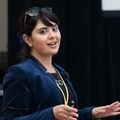Extrachromosomal circular DNA (eccDNA) comprises products of genomic recombination that cause somatic changes in gene length and sequence. These circular molecules are derived from canonical linear chromosomal loci, expanding the diversity in coding and regulatory capacity within eukaryotic genomes and transcriptomes. Using a brand-new multidisciplinary approach to investigate eccDNA-mediated allelic diversity, I have identified various coding regions of eccDNA biogenesis, such as Titin and Mucin loci. In order to systematically investigate the biological implications and mechanisms of eccDNA formation, this project will focus on Titin eccDNAs as a prototype for eccDNA-mediated chromosomal rearrangements. Titin (TTN) is an extremely large protein that is responsible for the passive elasticity of muscle, functioning as a molecular spring. This single gene (TTN) is expressed in various isoforms, each with its own associated “spring constant.” It has been assumed that Titin protein diversity results from complex mechanisms dependent on alternative RNA splicing. However, there is thus far no comprehensive alternative-RNA-splicing framework that accounts for the full spectrum of TTN diversity. Preliminary data obtained in the past years of support suggest a novel mechanism of TTN diversity involving circular-DNA excision that generates recombinant TTN loci at the genomic level. Here, I report TTN-eccDNA formation as a potential mechanism for modulating overall myofibrillar passive tension. Results from investigating this novel mechanism for the modulation of cardiovascular stiffness will revolutionize basic, clinical, and therapeutic approaches to cardiovascular diseases. The AOB Award has been instrumental in advancing the field of eccDNA, in general, and in providing a missing key element in DCM biology, consideration of which may drive a reevaluation of current therapies.

